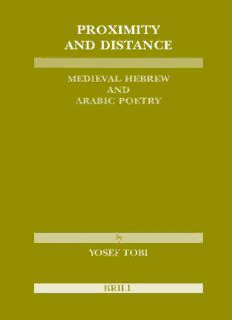
Proximity and Distance: Medieval Hebrew and Arabic Poetry (Etudes Sur Le Judaisme Medieval) PDF
Preview Proximity and Distance: Medieval Hebrew and Arabic Poetry (Etudes Sur Le Judaisme Medieval)
PROXIMITY AND DISTANCE ÉTUDES SUR LE JUDAÏSME MÉDIÉVAL FONDÉES PAR GEORGES VAJDA DIRIGÉES PAR PAUL B. FENTON TOME XXVII PROXIMITY AND DISTANCE PROXIMITY AND DISTANCE Medieval Hebrew and Arabic Poetry BY YOSEF TOBI TRANSLATED FROM THE HEBREW BY MURRAY ROSOVSKY BRILL LEIDEN•BOSTON 2004 This book is printed on acid-free paper. Library of Congress Cataloging-in-Publication Data Tobi, Yosef. [Keruv u-deÈiyah. English] Proximity and distance : medieval Hebrew and Arabic poetry / by Yosef Tobi. p. cm. — (Études sur le judaïsme médiéval, ISSN 0169-815X ; t. 27) Includes bibliographical references and index. ISBN 90-04-13798-X 1. Hebrew poetry, Medieval—Spain—History and criticism. 2. Hebrew poetry, Medieval—Middle East—History and criticism. 3. Hebrew poetry, Medieval—Arab influences. 4. Arabic poetry—History and criticism. I. Title. II. Series. PJ5023.T6313 2004 892.4’1209946—dc22 2004040777 ISSN 0169-815X ISBN 90 04 13798 X ©Copyright 2004 by Koninklijke Brill NV, Leiden, The Netherlands All rights reserved. No part of this publication may be reproduced, translated, stored in a retrieval system, or transmitted in any form or by any means, electronic, mechanical, photocopying, recording or otherwise, without prior written permission from the publisher. Authorization to photocopy items for internal or personal use is granted by Brill provided that the appropriate fees are paid directly to The Copyright Clearance Center, 222 Rosewood Drive, Suite 910 Danvers, MA 01923, USA. Fees are subject to change. PRINTEDINTHENETHERLANDS To my children: Zohara, Yannai, Dikla and Renana This page intentionally left blank CONTENTS Preface ........................................................................................ ix INTRODUCTION Chapter One Research on the Affinity of Hebrew Poetry to Arabic Poetry in the Middle Ages .................................. 3 PART ONE THE BEGINNING OF THE CONTACTS IN THE EAST Chapter Two The Encounter of Hebrew and Arabic Poetry in the East in the Tenth–Twelfth Centuries .......... 31 Chapter Three Sa'adia and Arabic Poetry: Philosophical Culture and Philosophical Poetry ........................................ 65 Chapter Four Sa'adia’s Poetics: Old Wine in a New Bottle ...................................................................................... 117 PART TWO HEBREW SECULAR POETRY IN SPAIN Chapter Five Hebrew Poetry and Arabic Poetry in Spain: Similarity and Distinctiveness ................................................ 179 Chapter Six Philosophy in Medieval Hebrew and Arabic Poetry in Spain ...................................................................... 205 Chapter Seven Medieval Hebrew Secular Poetry: Pagan Ideas Versus the Tenets of Judaism .......................... 217 viii contents Chapter Eight The Poetry of Sh6muel Ha-Nagid against the Background of Arabic Poetry of Self-Praise ................ 247 PART THREE THE POETICS OF HEBREW POETRY IN SPAIN Chapter Nine Metaphor in Hebrew Medieval Poetry ........ 269 Chapter Ten Modifications of Language and of Metre in Hebrew Medieval Poetry Compared with ∂arùrat al-shi'r, zi˙àfàt, and 'ilal in Medieval Arabic Poetry .......................... 291 Chapter Eleven The Source of Al˙arìzì’s t6na"e ha-shi'r (Conditions of Poetry) in 'amùd al-shi'r of Arabic Poetry .... 309 Chapter Twelve Aristotle’s Poetics in Medieval Jewish Literature ................................................................................ 323 APPENDICES Appendix One The Proverb Writer Sa'ìd B. Bàbshàd: A Tenth-Century Eastern Hebrew Poet .............................. 345 Appendix Two Sh6lomo b. Gabirol and Ba˙ye b. Paqùda: Philosophical Ideas in Spanish Liturgical Poetry ................ 356 Appendix Three A Poem by the Jewish Apostate to Islam Abraham B. Sahl? .................................................................. 364 Bibliography ................................................................................ 375 Indices ........................................................................................ 397 PREFACE The first steps in Hebrew secular poetry took place around the turn of the ninth century, under the evident impact of contemporary Arabic poetry. By that time the latter had become consolidated as a courtly poetry, in which luxury and pleasure were among the supreme aspects of social life. Nevertheless, this poetry still preserved many of the social and conceptual values by which it was charac- terized it its early stages in the jàhiliyya. Hebrew poetry was then written in accordance with Arabic poetic rules, in terms of content— jàhilì and courtly, prosody (metre and rhyme), linguistic outlook, and rhetorical texture. Students of Hebrew poetry who are fairly well acquainted with Arabic poetry have taken note of this link between the two. Such scholars include Sha"ul 'Abdallah Yosef and David Yelin in the first half of the twentieth century. A more systematic study has been con- ducted by contemporary scholars such as Y6huda Ratzaby, Israel Levin, and Arie Schippers. Indeed, it is simply impossible really to understand medieval Hebrew poetry without examining it against the Arabic poetry by which it was influenced and from which it lav- ishly borrowed conceptual as well as figurative, poetic, and linguis- tic values. The impact of the Arabic on the Hebrew poetry was so great that some researchers, incorrectly, define the latter as a poetic school which is distinct from the Arabic school only on account of its Hebrew language. All the above holds not only for secular poetry. It is also true of another genre created in Hebrew medieval belles-lettres, the maqàma; and even Hebrew sacred poetry, originating in the ancient Ereß- Israeli piyyut and intended for liturgical-religious use, was not free from the impact of Arabic poetry, although far less than secular Hebrew poetry. This critical approach, which I explicitly state on the title-page of this book, seemingly does not need to be proved or sustained, although there are scholars who disregard it or belittle and even deny it. Obviously, when approaching a person’s creative work to grasp and interpret it, particularly if he is of a time and place so remote from us, we should delve into the roots of its spiritual environment and
